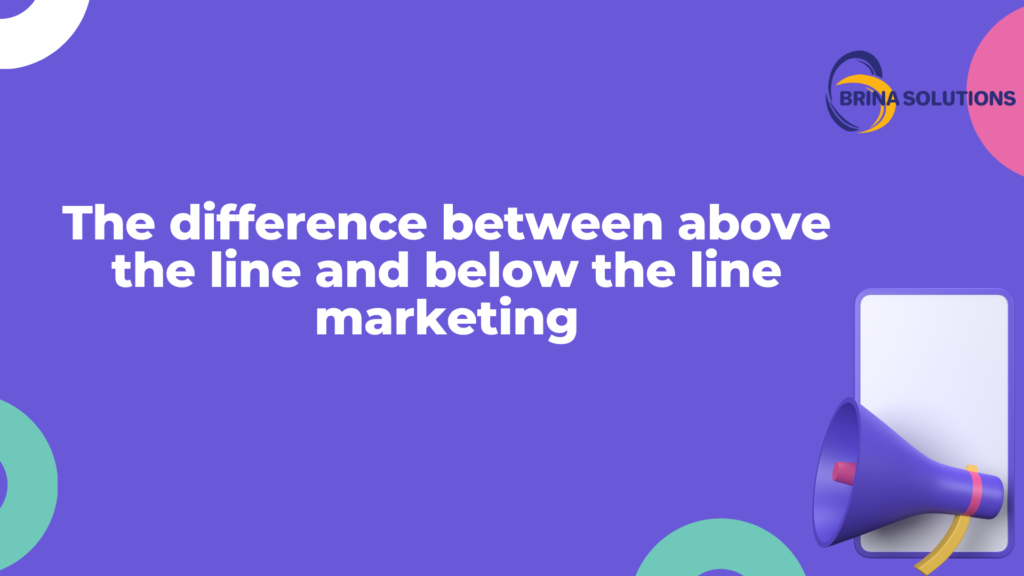In the ever-evolving world of marketing, businesses strive to create strategies that effectively reach their target audiences. Understanding the difference between Above the Line (ATL) and Below the Line (BTL) marketing is crucial for selecting the right approach to connect with potential customers. While traditional marketing relied heavily on mass media channels, the new school of marketing emphasizes personalized and data-driven methods. In this article, we’ll explore both concepts, compare techniques from traditional and modern perspectives, and provide actionable insights on how to choose the best approach for your business.

Understanding above the Line (ATL) Marketing
Above the Line marketing refers to promotional activities carried out on a large scale to create brand awareness and reach a wide audience. Traditionally, ATL marketing utilizes mass media channels such as television, radio, newspapers, and magazines. The goal is to broadcast a message to as many people as possible.
Traditional ATL Techniques:
- Television and Radio Advertising:
- Offers extensive reach, covering vast demographic groups.
- Suitable for building brand recognition and conveying emotional narratives.
- High production and placement costs but effective for creating memorable impressions.
- Print Media:
- Includes newspapers, magazines, and billboards.
- Best for targeting specific geographical areas.
- Limited in tracking engagement but powerful for visual and creative campaigns.
- Outdoor Advertising:
- Billboards, transit ads, and posters in high-traffic areas.
- Good for reinforcing brand visibility and driving foot traffic.
New School ATL Techniques:
- Programmatic Advertising:
- Automated buying of digital ad space based on audience behavior.
- Provides targeted reach similar to traditional ATL but with better analytics and flexibility.
- YouTube and Streaming Ads:
- Video ads before, during, or after streaming content.
- Combines the visual and auditory impact of TV ads with precise targeting.
- Podcast Sponsorships:
- Reaches niche audiences through host-read ads or episode sponsorships.
- Builds credibility and trust with engaged listeners.
Understanding below the Line (BTL) Marketing
Below the Line marketing focuses on direct, targeted communication, aiming to convert specific audiences into customers. BTL marketing is more measurable and personalized, using methods like direct mail, email marketing, and promotions.
Traditional BTL Techniques:
- Direct Mail:
- Personalized letters, postcards, or brochures sent to targeted addresses.
- Offers high customization but can be costly and time-consuming.
- Event Sponsorship and Trade Shows:
- Participation in or sponsorship of events to interact directly with potential customers.
- Ideal for networking, lead generation, and live demonstrations.
- Sales Promotions:
- Discounts, coupons, and special offers to stimulate short-term sales.
- Effective in driving impulse purchases and increasing brand loyalty.
New School BTL Techniques:
- Email Marketing:
- Segmented and personalized email campaigns.
- Automated workflows, drip campaigns, and behavior-based triggers improve engagement and conversion rates.
- Influencer Marketing:
- Collaborations with social media influencers to promote products.
- Leverages the influencer’s credibility and reach, especially in niche markets.
- Content Marketing:
- Blogs, videos, and infographics that educate or entertain the audience.
- Builds long-term relationships by providing value rather than directly promoting a product.
Comparing Traditional and New School Techniques
| Aspect | Traditional ATL/BTL | New School ATL/BTL |
| Reach | Broad, less targeted. | Highly targeted and customizable. |
| Cost | Often high, especially for TV. | Variable, often lower and scalable. |
| Measurement | Limited tracking. | Advanced analytics and real-time data. |
| Flexibility | Less adaptable to changes. | High flexibility with real-time tweaks. |
| Engagement | Passive audience engagement. | Interactive, fosters two-way communication. |
| Personalization | Limited. | Highly personalized messaging. |
Choosing the Right Approach
- When to Use ATL:
- Launching a new product or rebranding.
- Building widespread brand awareness.
- Targeting a broad demographic.
- When to Use BTL:
- Nurturing existing customer relationships.
- Promoting limited-time offers or specific products.
- When detailed targeting is necessary.
For most businesses, an integrated approach combining both ATL and BTL methods, known as Through the Line (TTL) marketing, is the most effective. For example, a company can launch a mass media TV campaign (ATL) to create awareness, followed by a series of email campaigns (BTL) to engage interested customers.
Bridging the Gap: How to Modernize Your Marketing Strategy
- Leverage Data and Analytics: Use data-driven insights to tailor both ATL and BTL campaigns. Tools like Google Analytics and CRM systems can help track customer behavior and campaign performance.
- Embrace Digital Transformation: Invest in digital channels such as social media, search engine marketing, and content marketing. These platforms offer cost-effective, targeted reach and measurable outcomes.
- Combine Tactics for Greater Impact: Integrate your ATL and BTL strategies. For instance, use a high-reach ATL campaign to drive traffic to a landing page, and then use BTL techniques like retargeting ads or email follow-ups to convert visitors.
Are you looking to create a balanced marketing strategy that combines the power of Above the Line and Below the Line techniques? At Brina Solutions, we specialize in developing tailored marketing strategies that align with your business goals. Whether you need a broad-reaching ATL campaign or a highly targeted BTL approach, our team of experts is here to help you achieve maximum impact. Contact us today to learn more about how we can elevate your brand’s visibility and drive growth!







1 comment so far